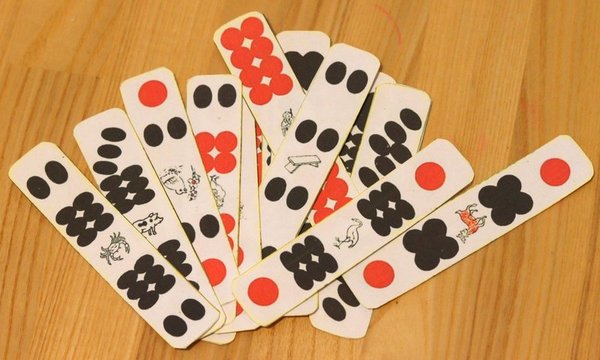Mo Hua Hua
Mo Hua Hua (抹花花, “wipe flowers”) is a three-player game played with a set of 48 paper dominoes. Mo Hua Hua rules can help you better understand the game of the Folk Tien Gow. To begin with, you need to make sure that you know the general principles of the game Tien Gow.
 Paper dominoes
Paper dominoes
There are also other games with paper dominoes, but usually there are already 84 or even 105 cards and they have four or five of each domino, that is, there is no asymmetry between civilians and military and it is more difficult to adjust them to a set of Chinese dominoes . That’s the reason I chose Mo Hua Hua among other games.
Tiles and ranking
Although a special set of paper dominoes is used for Mo Hua Hua, it can also be played with two sets of Chinese dominoes. The Mo Hua Hua game set has only 48 tiles. To do this, you need to take out the [3:1] tiles, and take out all military tiles except [6:3], [6:2], [4:2] and [2:1]. Technically that’s a double shortened deck.
Unlike in Tien Gow, in Mo Hua Hua, civilian and military tiles form the same suit and can beat each other, with civilians being stronger than military.
Combinations
Combinations in Mo Hua Hua can have two to four tiles and are similar to combinations in Folk Tien Gow. Supreme pair – [4:2][2:1] – beats nothing but cannot be beaten. Other combinations are as follows in descending order: Heaven ([6:6][6:6]) – Bull Pair ([6:3][6:2]) – Pendulum ([6:6][5:5][4 :4]) – Fish ([1:1][2:2][3:3]) – followed by all other combinations of civilian tiles in the usual order for Tien Gow.
Don’t be surprised that some combinations have two and some have three tiles. That’s fine. For example, [4:4][4:4][4:4] is a combination of three tiles that can be beaten, for example by [1:1][2:2][3:3], which in turn can be beaten by [6:3][6:2][6:2]. The number of tiles can be up to four. If it is a “Supreme” or “Bull” pair, Pendulum, or Fish combination, all the necessary tiles must be present for it to be a valid combination. That is, [6:3][6:3] is not a bull pair. But there can be more tiles in the combination – up to four, for example [1:1][2:2][3:3][3:3]. Moreover, [1:1][2:2][3:3][3:3] is greater than [1:1][1:1][2:2][3:3], because in such cases, the number of spots plays a role. The sources mention combinations of a larger number of tiles, but, unfortunately, it’s not exacrly clear how they look like. Therefore, we will assume that the largest combination is four tiles. Moreover, there are many variants of this game. This could be one of them.
Deal and bidding
Each player gets 16 tiles.
After a deal, one round of bidding is conducted. Bidding is simply “play” or “pass”. If all players have passed, the next player in the counter-clockwise direction becomes a dealer (and gets the right of the first move). If at least someone says “I’m playing”, then the game continues. There are no penalties or bonuses for passing or playing later on.
The progress of the game
At the beginning of the entire game, the dealer (and the right of the first move) is determined by lot. Then it goes counter-clockwise.
It is played in the usual way – you have to either beat the trick or put the tiles face down. A round is played up to 16 tricks.
Calculation
In the end of the game if a player has collected 6 to 10 tricks, other players pay him one chip each. If a player got 11 tricks, then he receives four chips from each player, plus an additional chip for each trick after 11. That is, if the player took 13 tricks, he will receive 6 chips from each player. Please note that two players can receive 6 tricks each. In this case, there are two winners, and one loser.
In addition to settlement at the end of the game, players also receive chips during the game under certain conditions. Specifically, if they take a trick with the Supreme or Bull pair, the rest of the players give him a chip. If the trick was taken with four identical tiles, then the player receives two chips from the rest of the players.
Conclusions
Mo Hua Hua game rules allow us making certain conclusions for the Folk Tien Gow. These are only my guesses though.
First, if a game is played with a set of all civilians plus [4:2][2:1], the civilian tiles can beat the military tiles if they were placed alone. This makes sense because otherwise the [4:2] tile would be invincible in a reduced deck game, as opposed to a full deck game where it can be beaten by all higher military tiles.
Second, bidding in Folk Tien Gow is probably just as simple. Players simply decide if they are willing to play that deal or if they don’t want to waste their time. Please note that the dealer role moves to the next player after everyone passes.
Third, it is possible that there is a similar calculation in the Folk Tien Gow, as in Mo Hua Hua. For example, it can be 1 point for 3-4 tricks; 3 points for 5 tricks + 1 point for each subsequent one. This roughly corresponds to the Chinese description, which mentions that there can be two winners.
The next game is Bagchen. Unlike Mo Hua Hua, Bagchen rules are well understood and described. This game is also the most complicated version of Tien Gow.
Sources:
- Mo Hua Hua description (Chinese)
- Mo Hua Hua description on Baike Baidu (Chinese)
- Mo Hua Hua and other games with paper dominoes on Pagat
Video sources (search for “掀牛九 紙骨” on ixigua)
- https://www.ixigua.com/7328840062815175219
- https://www.ixigua.com/6451843754788651534